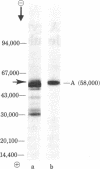Abstract
Monoclonal antibodies against a human plasminogen activator of Mr ≈52,000 (HPA52) were derived by immunization of mice with an impure preparation of the enzyme (urokinase), subsequent hybridization of spleen cells with NSI-Ag4/1 myeloma cells, and cloning of the hybridomas. Selection of mice for hybridization and screening of hybridomas were based solely on direct inhibition of an enzymatic assay of the plasminogen activator with the impure enzyme preparation. A cloned hybridoma produced IgG1 antibodies that bound to and inhibited the enzymatic activity of HPA52 irrespective of whether the HPA52 was derived from urokinase or from human glioblastoma cells, whereas there was no inhibition of or binding to a plasminogen activator of Mr ≈70,000 from human melanoma cells or a plasminogen activator of Mr ≈36,000 that is a degradation product of HPA52 and present in urokinase. Nor did the anti-HPA52 IgG1 inhibit a murine plasminogen activator of Mr ≈48,000 derived from sarcoma virus-transformed cells. By using affinity chromatography with columns of anti-HPA52 IgG1 bound to Sepharose, HPA52 was purified from urokinase to homogeneity as evaluated by NaDodSO4/polyacrylamide gel electrophoresis. This study demonstrates that inhibitory monoclonal antibodies against enzymes can be derived with the sole use of impure enzyme preparations and shows how such antibodies subsequently can be used for enzyme purification.
Keywords: hybridomas, screening, serine protease, urokinase
Full text
PDF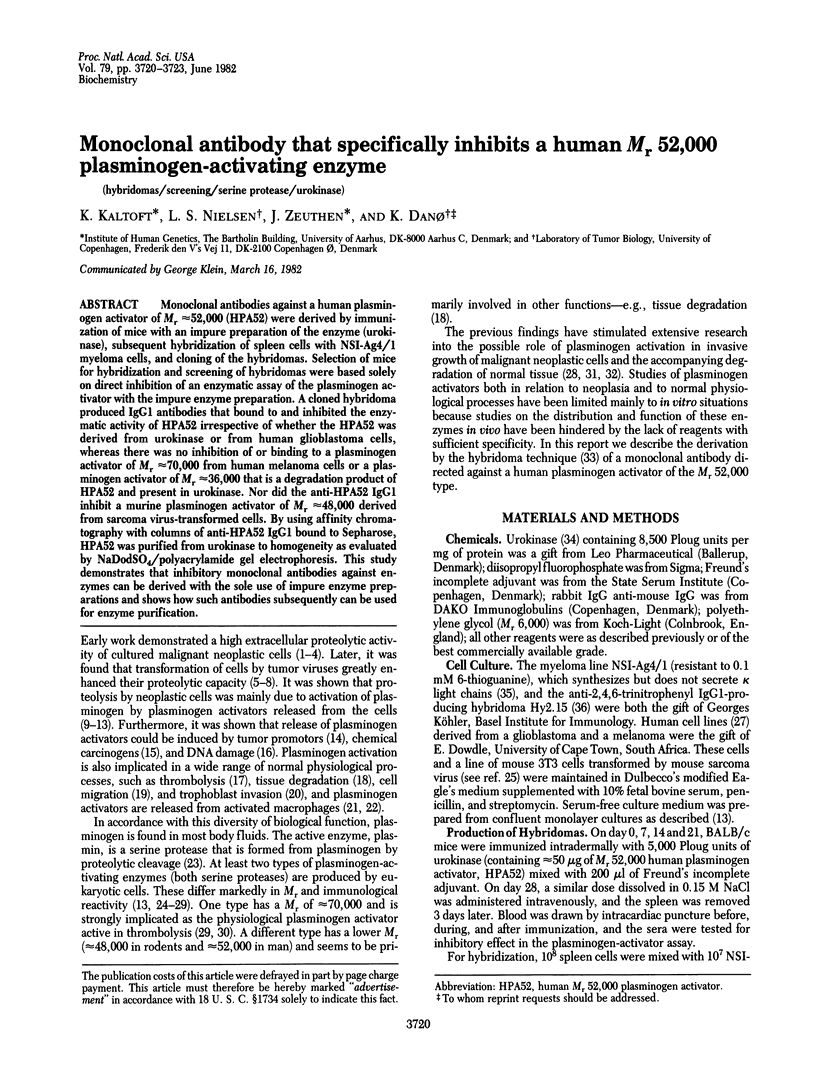
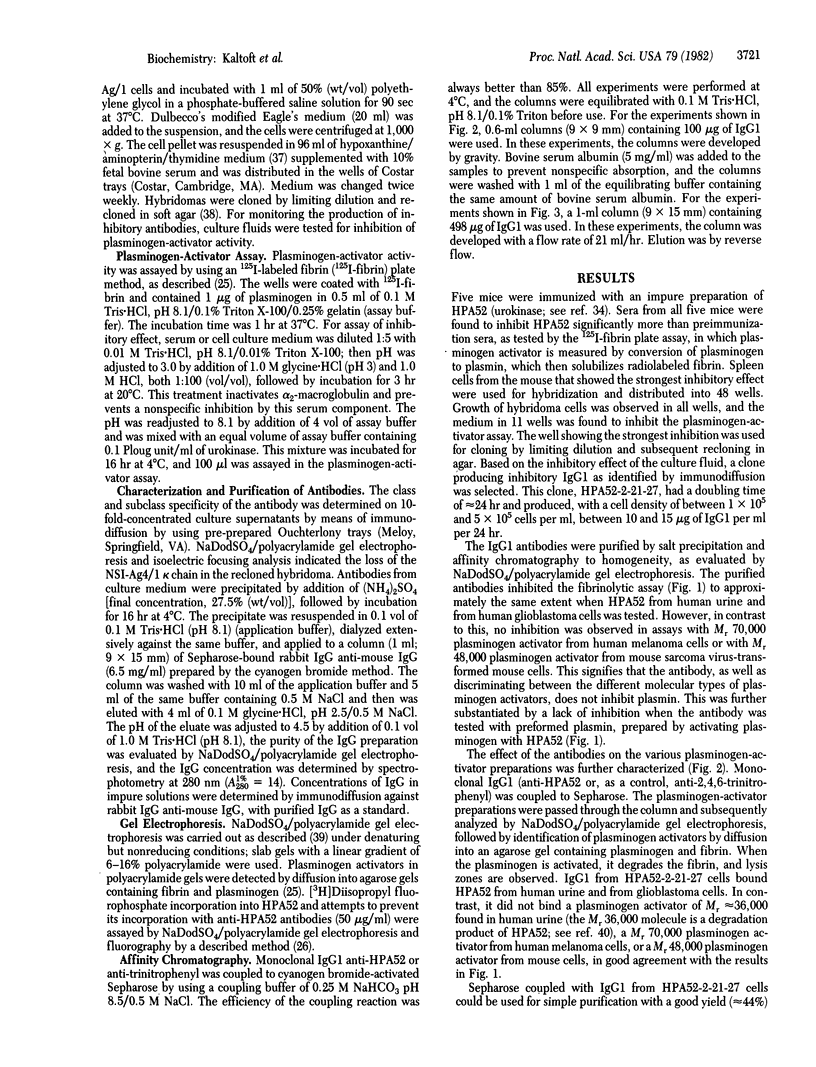
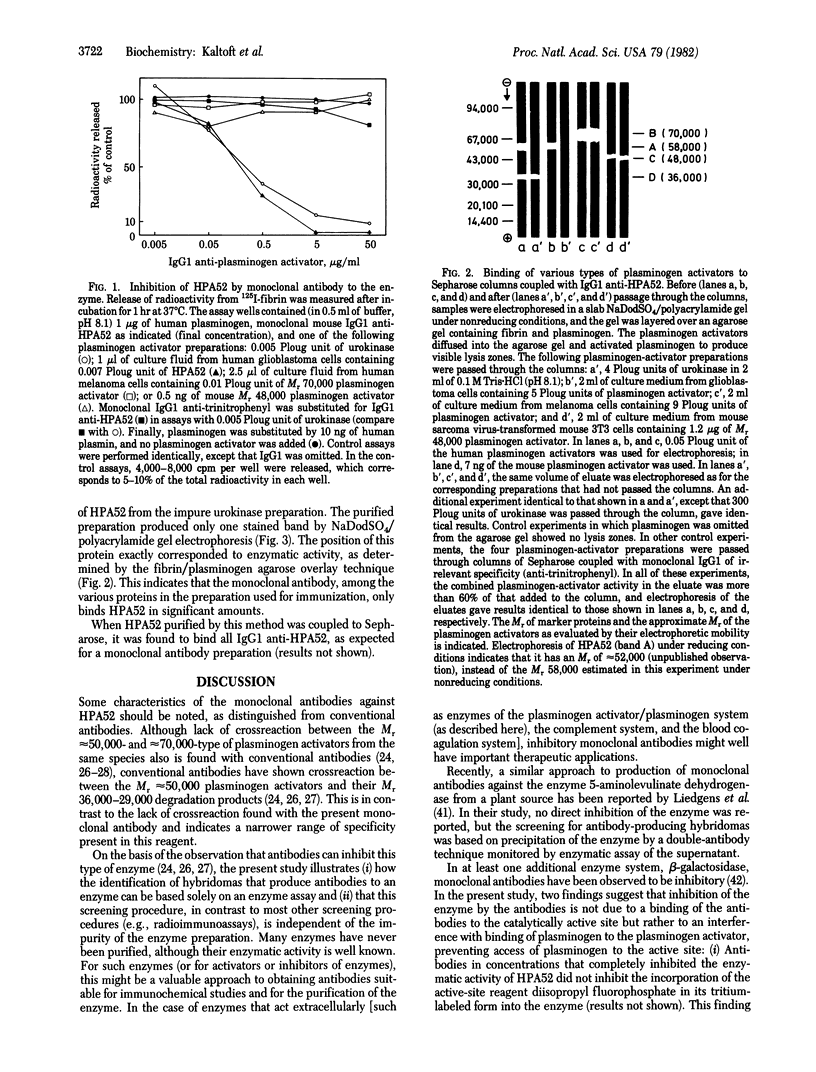
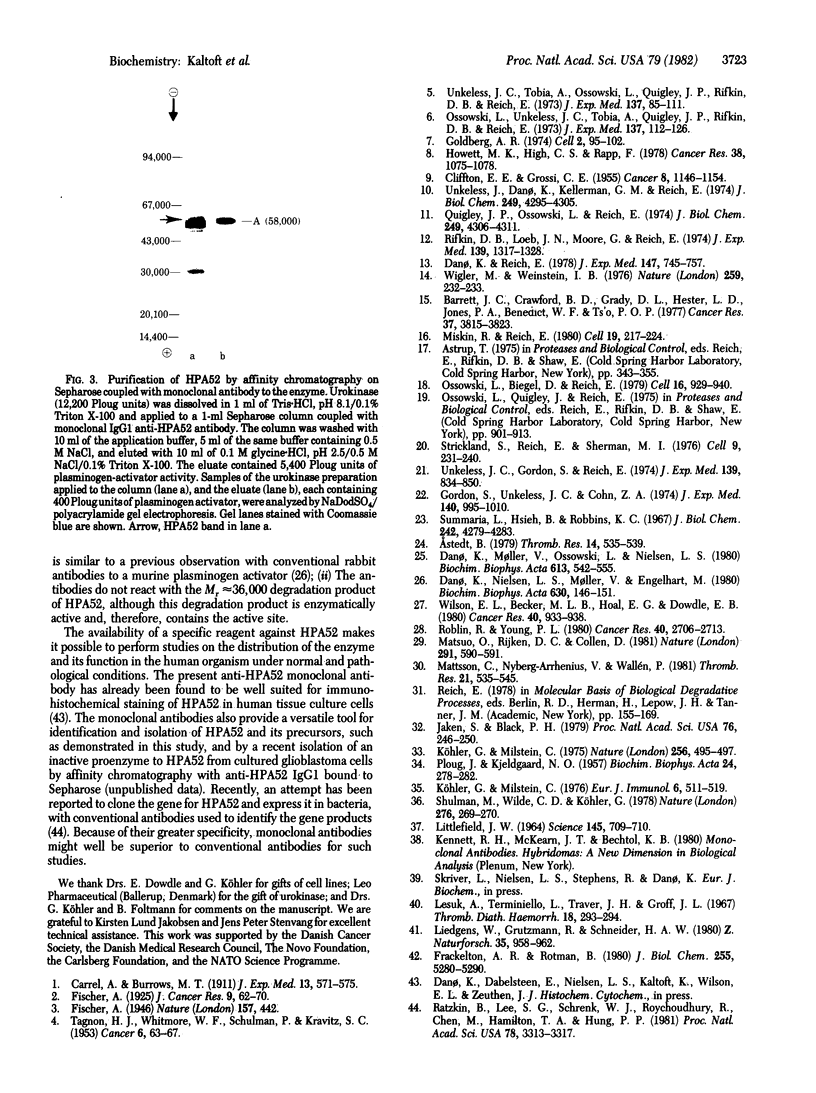
Images in this article
Selected References
These references are in PubMed. This may not be the complete list of references from this article.
- Astedt B. No crossreaction between circulating plasminogen activator and urokinase. Thromb Res. 1979;14(4-5):535–539. doi: 10.1016/0049-3848(79)90109-9. [DOI] [PubMed] [Google Scholar]
- Barrett J. C., Crawford B. D., Grady D. L., Hester L. D., Jones P. A., Benedict W. F., Ts'o P. O. Temporal acquistion of enhanced fibrinolytic activity by syrian hamster embryo cells following treatment with benzo(a)pyrene. Cancer Res. 1977 Oct;37(10):3815–3823. [PubMed] [Google Scholar]
- CLIFFTON E. E., GROSSI C. E. Fibrinolytic activity of human tumors as measured by the fibrin-plate method. Cancer. 1955 Nov-Dec;8(6):1146–1154. doi: 10.1002/1097-0142(1955)8:6<1146::aid-cncr2820080610>3.0.co;2-w. [DOI] [PubMed] [Google Scholar]
- Danø K., Moller V., Ossowski L., Nielsen L. S. Purification and characterization of a plasminogen activator from mouse cells transformed by an oncogenic virus. Biochim Biophys Acta. 1980 Jun 13;613(2):542–555. doi: 10.1016/0005-2744(80)90110-2. [DOI] [PubMed] [Google Scholar]
- Danø K., Nielsen L. S., Møller V., Engelhart M. Inhibition of a plasminogen activator from oncogenic virus-transformed mouse cells by rabbit antibodies against the enzyme. Biochim Biophys Acta. 1980 Jun 5;630(1):146–151. doi: 10.1016/0304-4165(80)90146-4. [DOI] [PubMed] [Google Scholar]
- Danø K., Reich E. Serine enzymes released by cultured neoplastic cells. J Exp Med. 1978 Mar 1;147(3):745–757. doi: 10.1084/jem.147.3.745. [DOI] [PMC free article] [PubMed] [Google Scholar]
- Frackelton A. R., Jr, Rotman B. Functional diversity of antibodies elicited by bacterial beta-D-galactosidase. Monoclonal activating, inactivating, protecting, and null antibodies to normal enzyme. J Biol Chem. 1980 Jun 10;255(11):5286–5290. [PubMed] [Google Scholar]
- Goldberg A. R. Increased protease levels in transformed cells: a casein overlay assay for the detection of plasminogen activator production. Cell. 1974 Jun;2(2):95–102. doi: 10.1016/0092-8674(74)90097-x. [DOI] [PubMed] [Google Scholar]
- Gordon S., Unkeless J. C., Cohn Z. A. Induction of macrophage plasminogen activator by endotoxin stimulation and phagocytosis: evidence for a two-stage process. J Exp Med. 1974 Oct 1;140(4):995–1010. doi: 10.1084/jem.140.4.995. [DOI] [PMC free article] [PubMed] [Google Scholar]
- Howett M. K., High C. S., Rapp F. Production of plasminogen activator by cells transformed by herpesviruses. Cancer Res. 1978 Apr;38(4):1075–1078. [PubMed] [Google Scholar]
- Jaken S., Black P. H. Differences in intracellular distribution of plasminogen activator in growing, confluent, and transformed 3T3 cells. Proc Natl Acad Sci U S A. 1979 Jan;76(1):246–250. doi: 10.1073/pnas.76.1.246. [DOI] [PMC free article] [PubMed] [Google Scholar]
- Köhler G., Milstein C. Continuous cultures of fused cells secreting antibody of predefined specificity. Nature. 1975 Aug 7;256(5517):495–497. doi: 10.1038/256495a0. [DOI] [PubMed] [Google Scholar]
- Köhler G., Milstein C. Derivation of specific antibody-producing tissue culture and tumor lines by cell fusion. Eur J Immunol. 1976 Jul;6(7):511–519. doi: 10.1002/eji.1830060713. [DOI] [PubMed] [Google Scholar]
- LITTLEFIELD J. W. SELECTION OF HYBRIDS FROM MATINGS OF FIBROBLASTS IN VITRO AND THEIR PRESUMED RECOMBINANTS. Science. 1964 Aug 14;145(3633):709–710. doi: 10.1126/science.145.3633.709. [DOI] [PubMed] [Google Scholar]
- Liedgens W., Grützmann R., Schneider H. A. Highly efficient purificaton of the labile plant enzyme 5-aminolevulinate dehydratase (EC 4.2.1.24) by means of monoclonal antibodies. Z Naturforsch C. 1980 Nov-Dec;35(11-12):958–962. doi: 10.1515/znc-1980-11-1215. [DOI] [PubMed] [Google Scholar]
- Matsuo O., Rijken D. C., Collen D. Thrombolysis by human tissue plasminogen activator and urokinase in rabbits with experimental pulmonary embolus. Nature. 1981 Jun 18;291(5816):590–591. doi: 10.1038/291590a0. [DOI] [PubMed] [Google Scholar]
- Mattsson C., Nyberg-Arrhenius V., Wallén P. Dissolution of thrombi by tissue plasminogen activator, urokinase and streptokinase in an artificial circulating system. Thromb Res. 1981 Mar 15;21(6):535–545. doi: 10.1016/0049-3848(81)90254-1. [DOI] [PubMed] [Google Scholar]
- Miskin R., Reich E. Plasminogen activator: induction of synthesis by DNA damage. Cell. 1980 Jan;19(1):217–224. doi: 10.1016/0092-8674(80)90403-1. [DOI] [PubMed] [Google Scholar]
- Ossowski L., Biegel D., Reich E. Mammary plasminogen activator: correlation with involution, hormonal modulation and comparison between normal and neoplastic tissue. Cell. 1979 Apr;16(4):929–940. doi: 10.1016/0092-8674(79)90108-9. [DOI] [PubMed] [Google Scholar]
- Ossowski L., Unkeless J. C., Tobia A., Quigley J. P., Rifkin D. B., Reich E. An enzymatic function associated with transformation of fibroblasts by oncogenic viruses. II. Mammalian fibroblast cultures transformed by DNA and RNA tumor viruses. J Exp Med. 1973 Jan 1;137(1):112–126. doi: 10.1084/jem.137.1.112. [DOI] [PMC free article] [PubMed] [Google Scholar]
- PLOUG J., KJELDGAARD N. O. Urokinase an activator of plasminogen from human urine. I. Isolation and properties. Biochim Biophys Acta. 1957 May;24(2):278–282. doi: 10.1016/0006-3002(57)90194-4. [DOI] [PubMed] [Google Scholar]
- Quigley J. P., Ossowski L., Reich E. Plasminogen, the serum proenzyme activated by factors from cells transformed by oncogenic viruses. J Biol Chem. 1974 Jul 10;249(13):4306–4311. [PubMed] [Google Scholar]
- Ratzkin B., Lee S. G., Schrenk W. J., Roychoudhury R., Chen M., Hamilton T. A., Hung P. P. Expression in Escherichia coli of biologically active enzyme by a DNA sequence coding for the human plasminogen activator urokinase. Proc Natl Acad Sci U S A. 1981 Jun;78(6):3313–3317. doi: 10.1073/pnas.78.6.3313. [DOI] [PMC free article] [PubMed] [Google Scholar]
- Rifkin D. B., Loeb J. N., Moore G., Reich E. Properties of plasminogen activators formed by neoplastic human cell cultures. J Exp Med. 1974 May 1;139(5):1317–1328. doi: 10.1084/jem.139.5.1317. [DOI] [PMC free article] [PubMed] [Google Scholar]
- Roblin R., Young P. L. Dexamethasone regulation of plasminogen activator in embryonic and tumor-derived human cells. Cancer Res. 1980 Aug;40(8 Pt 1):2706–2713. [PubMed] [Google Scholar]
- Shulman M., Wilde C. D., Köhler G. A better cell line for making hybridomas secreting specific antibodies. Nature. 1978 Nov 16;276(5685):269–270. doi: 10.1038/276269a0. [DOI] [PubMed] [Google Scholar]
- Strickland S., Reich E., Sherman M. I. Plasminogen activator in early embryogenesis: enzyme production by trophoblast and parietal endoderm. Cell. 1976 Oct;9(2):231–240. doi: 10.1016/0092-8674(76)90114-8. [DOI] [PubMed] [Google Scholar]
- Summaria L., Hsieh B., Robbins K. C. The specific mechanism of activation of human plasminogen to plasmin. J Biol Chem. 1967 Oct 10;242(19):4279–4283. [PubMed] [Google Scholar]
- TAGNON H. J., WHITMORE W. F., Jr, SCHULMAN P., KRAVITZ S. C. The significance of fibrinolysis occurring in patients with metastatic cancer of the prostate. Cancer. 1953 Jan;6(1):63–67. doi: 10.1002/1097-0142(195301)6:1<63::aid-cncr2820060105>3.0.co;2-l. [DOI] [PubMed] [Google Scholar]
- Unkeless J. C., Gordon S., Reich E. Secretion of plasminogen activator by stimulated macrophages. J Exp Med. 1974 Apr 1;139(4):834–850. doi: 10.1084/jem.139.4.834. [DOI] [PMC free article] [PubMed] [Google Scholar]
- Unkeless J. C., Tobia A., Ossowski L., Quigley J. P., Rifkin D. B., Reich E. An enzymatic function associated with transformation of fibroblasts by oncogenic viruses. I. Chick embryo fibroblast cultures transformed by avian RNA tumor viruses. J Exp Med. 1973 Jan 1;137(1):85–111. doi: 10.1084/jem.137.1.85. [DOI] [PMC free article] [PubMed] [Google Scholar]
- Unkeless J., Dano K., Kellerman G. M., Reich E. Fibrinolysis associated with oncogenic transformation. Partial purification and characterization of the cell factor, a plasminogen activator. J Biol Chem. 1974 Jul 10;249(13):4295–4305. [PubMed] [Google Scholar]
- Wigler M., Weinstein I. B. Tumour promotor induces plasminogen activator. Nature. 1976 Jan 22;259(5540):232–233. doi: 10.1038/259232a0. [DOI] [PubMed] [Google Scholar]
- Wilson E. L., Becker M. L., Hoal E. G., Dowdle E. B. Molecular species of plasminogen activators secreted by normal and neoplastic human cells. Cancer Res. 1980 Mar;40(3):933–938. [PubMed] [Google Scholar]



